恋恋布达佩斯
2009-06-01CarolinaKovacs
Carolina Kovacs
编者按:匈牙利首都布达佩斯是全国政治、经济和文化中心,也是欧洲著名的古城。它风光秀丽,景色如画,被人们誉为“多瑙河畔的明珠”。它是大诗人裴多菲、音乐家李斯特以及翻云覆雨的金融巨鳄索罗斯的故乡,还是茜茜公主爱恋的土地,那么,今天就让我们一起随着作者来感受这座曼妙的城市吧。

I dont think theres anything more beautiful in the world than the Danube on a clear summer day.In the clear light, with the water sparkling, you can see the deep intensity of colour which caused the great river to be known as the Blue Danube. Incredibly wide, it seems more like a sea than a river; it takes fifteen minutes or more to walk across it at points. It looks so pure you can drink it – that wouldnt be a good idea, though!
我认为世界上再也没有任何事物能够美过明朗夏日里的多瑙河。在明亮的日光中,波光潋滟,你能看见使得这条河的颜色是多么的深,这正是它被誉为“蓝色多瑙河”的原因。河面宽阔得令人难以置信,更像是一片海。步行穿过它要花上十五分钟甚至更久的时间。多瑙河看起来如此纯净,你甚至会想尝上一口——但这可不是个好主意。
The Danube cuts right through one of my favourite cities in the world, Budapest. In fact, the Hungarian capital was originally two cities, Buda and Pest. Pest was a political and trading city, sleepy Buda, set among the hills on the other side of the river, a place for the Hungarian nobility to relax. The two halves of the city still keep the same feel, and people will talk of going over to Buda for the day. Pest is a thriving urban metropolis, full of shopping malls and new skyscrapers, while Buda is less a city than a big country town, a lovely place to wander about and smell the fresh air.
多瑙河正好穿过世界上我最爱的城市之一——布达佩斯。实际上,匈牙利的首都最初是两个城市,布达和佩斯。佩斯曾是一个政治经济城市,而安静的布达则依偎在河流另一边的山脉下,成为匈牙利著名的休闲地。这座城市的两个部分仍然保持着同样的感觉,人们会谈论着“去布达游玩”。佩斯是一个兴旺发达的现代都市,商场密布,高楼林立,而布达则更像一个乡村城镇,是一个适合四处闲逛、呼吸新鲜空气的好地方。
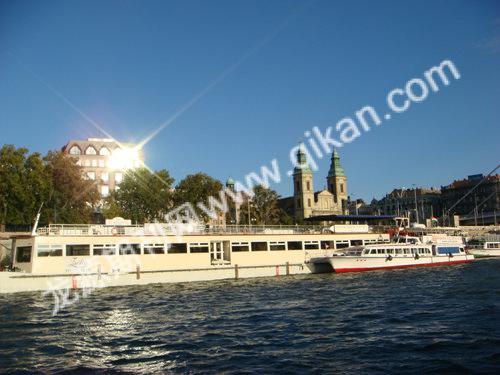
I was in Budapest on a long trip round Europe after finishing a Ph.D. After several years of being buried in scholarly detail, I was looking forward to just relaxing, seeing parts of the continent I had never been to, and catching up with old friends. I wanted to follow the great rivers in particular, the Danube and the Rhine and so on; I love to swim and to paddle, and always preferred rivers and seas to pools. Budapest wasnt new to me. My fathers family is Hungarian (and my name, Kovacs, is a very common one in the country) and I had been there as a child – but this was my first time to look at the city with adult eyes.
结束博士课程后我进行长期环欧旅行并来到了布达佩斯。埋头于学术研究数年,我期待着能够好好放松一下,看看我从没有见过的一些欧洲大陆国家,会会老朋友。尤其想追随伟大的河流,多瑙河、莱茵河等等。我喜欢游泳,还有泛舟水面,相比较于池塘,我一直都更喜欢河流与大海。布达佩斯对我而言并不陌生,我父亲的家在匈牙利(我的名字Kovacs在这个城市非常普遍),我的童年是在那里度过的,但这是我第一次用成人的目光来打量这座城市。

The city had changed almost beyond my comprehension since the 1980s, too. Back then, Budapest was still behind the Iron Curtain, part of the Soviet bloc; it had only become truly independent in 1989. While the suburbs were still full of dark Soviet-style housing blocks, the city centre itself, which I remembered as being drab and grey, had been transformed in the last twenty years. The buildings were only painted up to twenty feet or so, because that was the highest that a visiting Russian official could see from his limousine. Everywhere I looked there were flashy advertisements, new supermarkets, brand-name stores and coffee shops. On the edges there were plenty of more dubious establishments, like strip clubs, a sign that the new society wasnt always pleasant, but the city was thriving, the streets busy and the shops full. Budapest is a university town – not only the old Budapest institutes are based there, but also the new Central European University, founded by multi-millionaire George Soros and full of students from dozens of countries.
这个城市自上个世纪八十年代以来也变得超出我的理解能力之外。回想那时,布达佩斯仍旧处于“铁幕”之下,作为苏维埃政权的一部分,直到1989年它才真正独立。而郊区仍满是黑色的苏维埃式建筑,我记忆中城市中心满是褐色以及灰色的建筑都在过去二十年里全部改变了。所有的建筑物曾经都只粉刷到大约二十英尺,因为这是来访的俄国军官坐在豪华轿车里所能看到的最高高度。环顾四周我所能看到的都是俗丽的广告、新兴超市、品牌商店以及咖啡馆。在不显眼的地方有很多可疑的建筑物,像脱衣舞夜总会,标志着这个新兴的社会并不是一直那么愉悦,但是这个城市是繁荣的,街道是忙碌的,商店里更是熙来攘往。布达佩斯是一个大学城——不仅拥有多所历史久远的布达佩斯学院,还有新兴的中欧大学,它是由大富豪乔治•索罗斯建立,无数国家的学生云集其中。

Student life centred around Budapests many coffee shops, from big, glitzy places in the lobbies of old hotels to small, cosy establishments in basements where you sat on huge bean bags and drunk from oversize mugs. I gorged myself on Hungarian and Austrian cakes, ruining months of dieting with chocolate and toffee. Not only students attend these wonderful cafes, however, but all kinds of people from different walks of life; old grandmothers, young kids just out of school, businessmen taking a break from work. The chatter of a dozen different languages can be heard; German, Hungarian, French, Bulgarian, English. Budapest has always been a multicultural and multilingual city, a gateway between the two Europes, East and West. Part of this, of course, is that nobody else speaks Hungarian, a horrendously difficult language totally separate from other European tongues, and so Hungarians have always been forced to be adept linguists. I speak very poor Hungarian, but barely had a chance to practice it, since as soon as my interlocutor found I was a foreigner they would switch to German or English.
学生们的生活都集中在布达佩斯的众多咖啡馆里,从位于旧式旅馆大厅中的豪华大型咖啡馆到位于地下室的舒适小巧咖啡店,后者你可以坐在装满豆子的大袋子上,用超大的杯子喝咖啡。我美美地享受了匈牙利和奥地利蛋糕,还有让我坚持数月的减肥计划功亏一篑的巧克力和太妃糖。然而,不仅仅只有学生才来咖啡馆,还有来自各个不同的阶层的人;年迈的祖母,刚刚放学的年幼的孩子以及工作之余小憩的商人。你可以听见很多种不同的语言在交流,德语、匈牙利语、法语、保加利亚语还有英语。布达佩斯一直都是一个多文化、多语言的城市,东欧和西欧的桥梁。当然,也许这是原因之一,其他人都不会说匈牙利语——一种异常难学、完全不同于欧洲其他发音的语言,所以匈牙利人一直被迫成为通晓各国语言的语言学家。我只会说一点点匈牙利语,但很少有机会练习,当谈话的人发现我是外国人时人们就会转而使用德语或者英语。
As I walked along, I suddenly heard music, and saw an orchestra playing by the side of the river, in an old square. A few hundred people were gathering around, listening – but not with any great reverence, but chatting and laughing among themselves, enjoying the summer day. The orchestra was playing Liszt, Hungarys most famous musical son, but they werent the only musicians out that day. Walking further, I heard jazz, rock, blues, soul – it was the middle of the Budapest Music Festival, bringing music out into the open air for people to enjoy for free! Everybody seemed to be enjoying it, and I was no exception; the combination of music, clean summer air, and the deep beauty of the river made it an almost perfect day.
当我漫步在大街上时我忽然听见了音乐声,并看见一个管弦乐队正在河边的一个老广场演奏。一些人正围在四周倾听——但并没有带着多少敬意,他们不停地谈笑着,享受着夏日时光。这个管弦乐队正在演奏著名的匈牙利音乐巨子李斯特的曲子,但他们并不是那天唯一的音乐家。再往前走,我就听见爵士、摇滚、蓝调还有灵魂乐——当时正是布达佩斯音乐节,将音乐带到户外让更多人免费欣赏。大家看起来都很享受,我也不例外。音乐、清新的夏日气息还有多瑙河的异常美丽交织在一起,造就了近乎完美的一天。

But the Danube also brought an unexpected moment of sadness, too. On the banks, I saw an odd sculpture. It looked like a cluster of discarded old shoes, but looking closer I saw that they were made of bronze, and fixed to the street. A small plaque explained that this was a memorial for the Hungarian Jews murdered by the Arrow Cross Militiamen, the Hungarian Fascist Party who briefly and lethally ruled the city in 1944-1945. Hundreds of Jews had been lined up along the bank and shot, their bodies falling into my beautiful river.
但多瑙河也有意想不到的悲伤时刻。河岸边,我看见一座奇怪的雕塑。它看起来像是废弃的旧鞋子堆积而成,但是走近细看我发现它们是用铜制作的,固定在街道上。一块小匾解释说这是为了纪念1944到1945年期间被残酷统治这座城市的匈牙利纳粹组织“箭十字军”所枪杀的数百名匈牙利犹太人。他们被排成一排在河岸边枪杀,身体相继掉进美丽的多瑙河中。
There were prouder moments of history, though. Just ahead of the shoes, rising above the embankment, was the magnificent neo-Gothic building of the Hungarian Parliament. Huge and spiky, it looms over the river, visible for miles around. Three hundred metres long and a hundred metres high, its the largest building in the country, and is a maze of rooms and corridors and halls inside. Going in, I was surrounded by statues; past Hungarian kings and leaders and heroes looked sternly down on me from the alcoves, along with fierce-looking lions. (There are another pair of lion statues on a bridge just down from the Parliament, but theyre foreigners – built in Britain, and erected by the Scottish engineer hired to build the bridge.) Inside, a kindly old guide explained some of the treasures and kings to me, tolerating my poor Hungarian even though his English was far better.
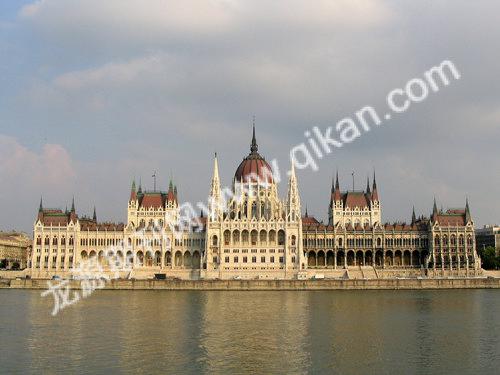
但也有历史上骄傲的瞬间。就在鞋子前面,河堤之上,那里是宏伟的新哥特式匈牙利国会大厦。这座建筑物体积庞大,顶尖高耸,在河面上若隐若现,在几英里外都能看见。匈牙利国会大厦宽300米,高100米,是这个国家最大的建筑物,里面尽是迷宫似的房间、走廊以及大厅。走入其中,我被雕像包围,过去的匈牙利国王还有首领以及英雄们和凶猛的狮子一起从高处表情严峻地看着我。(直通国会大厦的桥上也有两座狮子,不过它们是外来者——在英国建造,由修建这座大桥的苏格兰工程师所竖立。)在里面一位善良的老向导向我解释了这些珍宝和国王,尽管他的英语要好得多,但还是忍受着我糟糕的匈牙利语。
I went to its counterpart in Buda the next day. The Castle Hill was the seat of the old Hungarian kings, before the country became united under one contentious monarchy with Austria – the cause of many struggles and revolutions since, until Hungary became independent after the First World War. (This is imprinted in local culture; Hungarians will still not toast with beer, only wine, because the Austrians toasted with beer after hanging the Hungarian rebels of 1848.) As the name says, the castles and palaces are on the top of one of Budas many hills, looking down on the river.For a simple American girl like me, the huge halls and beautiful palaces on the hill were wildly romantic, like something out of a fairytale. You cant get into everything, but the bits I could see were fantastic; huge marble staircases and giant chandeliers. A lot of the space was given up to museums about the history of Budapest itself, but I largely ignored those and concentrated on the glory of the landscape.
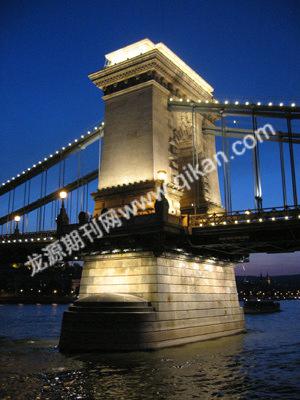
第二天我就来到布达一个和它相当的著名景点。在匈牙利与奥地利被饱受争议的政权统一前(这也是在一战后匈牙利独立前战争革命不断的原因),盖勒特山丘是匈牙利国王的所在地。(这一点被当地文化所铭记,匈牙利人依旧不用啤酒庆祝,只用白酒,因为奥地利人在1848年绞死匈牙利革命军后就是用啤酒欢庆的。)就如同名字一样,城堡和宫殿都位于布达山脉之巅,从高处俯览河流。对于一个淳朴如我的美国女孩来说,这种建在山脉上的宏伟的大厅和宫殿简直浪漫到极致,就像从童话中走出来的一般。你无法走进所有的景点,但是所有我眼见之物都充满奇幻色彩,硕大的大理石阶梯以及巨大的支形吊灯。而更多的空间则留给了讲述布达佩斯历史的博物馆,但我几乎忽视了这些,完全沉溺于景色的壮丽。
Soon afterwards, my friend Elizabeth introduced me to a more homespun pleasure; outdoor bathing! The Danube is spotted with islands, and some of them have big public baths on them.She took me to the most famous, Margaret Island. Thousands of families go there every day in the summer, splashing and swimming and playing in massive outdoor pools. We went to a smaller spa, luxuriating in the gorgeous water and flirting with the boys who come there to meet girls. I was chatted up by a gorgeous athlete called Matthias, over six feet tall and with a dazzling white smile, who didnt seem put off when I mentioned my boyfriend back in the USA. The boys took us around the rest of the island later, treating us to a picnic in one of the wooded areas and throwing bits of bread to the squirrels which run all over the island.
稍后不久,我的朋友伊丽莎白介绍我去享受一种更为简单自然的快乐,露天游泳!多瑙河被无数小岛点缀着,其中一些拥有大型公众浴场。她带我去了最出名的玛格烈岛。成千上万的家庭在夏季每天都去那里,在大型户外池塘里戏水、游泳和玩耍。我们去了一个较小的矿泉,在极其舒适的水里享受着,并和前来搭讪的男孩聊天。我被一个名叫马提亚的帅气运动员搭讪,他有6英尺多高,笑的时候露着一口白牙,在我提及在美国的男朋友时也毫不气馁。稍后男孩们带着我们逛了逛岛上其它的地方,在野地里进行野餐来招待我们,并将面包屑喂食岛上四窜的小松鼠。
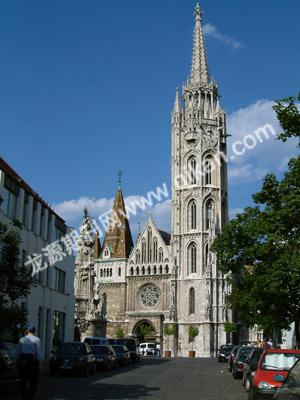
Outside of Budapest, you can take ferries up the river to see other major Hungarian sites. It doesnt take long, as this is a tiny country – you could drive across it in a few hours. I took a boat up to see Visegrad, another magnificent Hungarian castle, built as a summer palace for one of the old kings, Matthius Corvinus. On the boat back, enjoying the stillness of the river and the chatter of my companions, I thought about how lucky I was to see this small, charming country, and where I could follow the Danube to next.
出了布达佩斯,你可以乘船去看看匈牙利其它的大城市。这个国家不大,不会花费太久时间——你甚至只需几小时驱车就可以穿过整个国家。我乘船去游览了维谢格拉德——匈牙利另一个雄伟的城堡,是为古代一个国王马查什•科韦努斯所建的夏日行宫。在乘船回来的路上,享受着河面的宁静,与同伴们闲谈,我觉得自己何其幸运看见了这个小巧、迷人的国家,在这里我可以沿着多瑙河继续前行。
Tips
著名景点
马伽什教堂:马伽什大教堂由匈牙利历史上最成功的皇帝马伽什所建,马伽什是一位狂热的艺术爱好者和建筑鉴赏家。在他统治期间,大量翻新、增盖建筑,把布达佩斯、埃斯泰尔戈姆、维塞格拉德变成华丽的城镇;至今,教堂地下的珍宝馆中,还收藏着茜茜公主戴过的白金面纱。
渔人堡:渔人堡建于1905年,最早曾是个鱼市,后来渔民们为了保护自己的利益而修建了此堡,作为防御之用。米白色的建筑、仿佛童话城堡般的造型,加上独特的地理位置,站在这里可以鸟瞰布达佩斯全城美丽的风光。
圣•史蒂芬国王雕像:圣•史蒂芬国王是匈牙利第一个天主教国王(公元1000年加冕),同时也可以说是匈牙利国的建立者。
链子桥:链子桥于1839年开始兴建,1849年完成,二次大战期间德军为了巩固他们在城堡山上的堡垒,将桥梁全部炸毁,历经战后的重建,链子桥在完工后的一百年即1949年重新通行。链子桥是第一座真正连接佩斯与布达两城的永久性建筑。正如塔桥是伦敦的标志一样,链子桥多少年来一直是布达佩斯的象征。
英雄广场:英雄广场的中央是一尊高达36米的巨型纪念碑,名曰:千年纪念碑。是1896年为了纪念率领凯旋的匈牙利民族进驻喀尔巴阡盆地1000年而建。在纪念碑的顶端加百利一手高举罗马教皇的十字架,一手持匈牙利的王冠展翅赐福匈牙利。碑座平台上是阿尔帕德及他率领的6个主要部落的首领。碑后方,是两个半圆形廊柱,陈列着历代的明君圣主,或战功显赫的将军们。
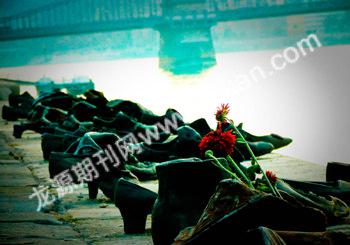
最佳旅游季节
布达佩斯有着错综复杂的历史,所以每个季节都有自己的节日。6月的布达佩斯节是火热的摇滚乐和流行音乐节,9月是国际葡萄酒与香槟节,在城堡地区举行。在布达佩斯夏日歌剧和芭蕾舞节能欣赏到最好的高尚文化。
交通
只要不是积雪太多,布达佩斯大部分地方都非常适合骑自行车,包括城市和纳普里格的公园、玛格丽特岛、欧布达岛和赛培尔群岛和布达小山。你可在玛格丽特岛和城市公园租单车,悠然游走。布达佩斯公交车有两种,蓝色的是市区车,黄色的是郊区车。车票可以到报刊亭、自动售票机、地铁口购买。如果您有布达佩斯卡的话,可以免费乘坐布达佩斯交通公司的所有公共交通工具。
布达佩斯卡
如果拥有布达佩斯卡,那么在刚到达机场的时候就可以更便宜地叫上一辆小巴士了。而在市区,则能将这种卡作为公共交通工具的车票使用。有了布达佩斯卡,还能在特定的博物馆、以及动物园、游乐园、布达的地下溶洞获得优惠门票或免费进入。用这种卡,在城市观光旅行和一些文化活动中可享受优惠,而且在一些特定的餐馆、咖啡馆和商店中,持卡者也可获得较为便宜的价格。
小费
一般情况下支付小费金额是总价格的10%,要客人根据服务质量而定。
Notes
1. wander about
意为“徘徊、转来转去”。
例句:Don't wander about the room like that. Get something to do.
不要那样在房间里乱走,找点事情做。
2. bury
该词语有多种意思,最常见的就是“埋葬;掩埋、埋藏”,在这句话中指的是“沉溺于、专心于”。
例句:The old man is burying his money.
老头正在埋藏他的钱。
Her head was buried in a book.
她在埋头读书。
3. Iron Curtain
铁幕。指的是冷战时期将欧洲分为两个受不同政治影响区域的界线。当时,东欧属于苏联(共产主义)的势力范围,而西欧则属于美国(资本主义)的势力范围。这个词出自英国首相温斯顿•丘吉尔在美国密苏里州富尔敦城的威斯敏斯特学院所发表的题为《和平砥柱》的演讲。
4. walk of life
意为“行业、社会阶层”。
例句:She did not want her son to marry a girl in a different walk of life.
她不希望儿子和一个门不当户不对的姑娘结婚。
5. get into
意为“进入、陷入;对……发生兴趣;养成”,在文中指的是“作者没有被允许进入所有的地方”,就像你去某些地方旅游,有的景点并不对外开放。
例句:They will get into London this afternoon.
他们今天下午会到伦敦。
Again they got into difficulties.
他们再次陷入困境。
6. put off
意为“延期;阻碍做某事;使分心;关掉;丢弃, 摆脱;敷衍, 推诿;脱去(衣、帽等)”,该词组释义很多,所以要根据上下文来做出正确的理解。在本文中指的是“当作者提到她有男友的时候,那个男孩并没有气馁,还是继续和她谈天说地”。
例句:I don't like music playing when I'm working. It puts me off.
我不喜欢工作时放音乐,那会使我分心。
When he asked her to name a day for their wedding, she put him off.
当他要她订个结婚的日子时,她却支支吾吾不说。
Links
1. Liszt Ferenc弗朗兹•李斯特
弗朗兹•李斯特是匈牙利著名的作曲家、钢琴家、指挥家和音乐活动家,浪漫主义音乐的主要代表人物之一。他六岁起开始学习音乐,并于此后不久移居维也纳,曾先后作为萨里埃里、车尔尼、雷哈、巴埃尔的弟子。在音乐上他主张标题音乐,首创了交响诗体裁,作有《塔索》、《前奏曲》、《匈牙利》等交响诗共十三部。李斯特还受帕格尼尼的影响,创作了十九首《匈牙利狂想曲》和十二首钢琴练习曲以及超技练习曲。这些作品不但充分发挥了钢琴的音乐表现力,而且,为狂想曲这个音乐体裁创作树立了杰出的音乐典范。他还树立了与学院风气、市民习气相对立的新的浪漫主义原则,并支持阿尔贝尼斯、斯美塔那、肖邦、柏辽兹、瓦格纳等作曲家的创作。相传贝多芬听了他的演奏后,非常赞赏他的天才,曾上台拥抱亲吻李斯特,这成为李斯特音乐成长的佳话。在他的祖国,人民始终尊崇他为伟大的“民族艺术家”。
2. George Soros金融巨鳄索罗斯
乔治•索罗斯号称“金融天才”,从1969年建立“量子基金”至今,他创下了令人难以置信的业绩,以平均每年35%的综合成长率令华尔街同行望尘莫及。他好像具有一种超能的力量左右着世界金融市场。他的一句话就可以使某种商品或货币的交易行情突变,市场的价格随着他的言论上升或下跌。
曾有评论形容索罗斯犹如华尔街上的一头金钱豹,行动极其敏捷,善于捕捉投资良机。一旦时机成熟,他将有备而战,反应神速。虽然在华尔街,索罗斯是一名大家熟知的高手,但真正让他为外界所了解的,却是90年代的两次大危机,而这两次危机,索罗斯都是关键人物。其一是1992年的英格兰银行事件。也许他能不断制造世界金融界神话的最大秘诀之一就是他具有超人的心理素质。索罗斯喜欢隐于幕后,他曾长期有意避开新闻媒体,不愿抛头露面。因为在他看来,经营一个全球性的投资公司,一旦人们知道你在做什么,他们就会先于你去做,这样,就会打乱公司的投资计划。所以,名声有时对于一个投资者来说并非好事,而只会带来灾难。
索罗斯是LCC索罗斯基金董事会的主席,民间投资管理处确认他作为量子基金集团的顾问。量子基金在量子集团内是最老和最大的基金,普遍认为在其28年历史中在全世界的任何投资基金中具有最好的业绩。
索罗斯曾获得社会研究新学院、牛津大学、布达佩斯经济大学和耶鲁大学的名誉博士学位。1995年波伦亚大学(意大利)将最高荣誉——Laurea Honoris Causa授予索罗斯先生,以表彰他所取得的成就。
3. Shoes Along the Danube多瑙河畔的鞋子
1944年4月16日,匈牙利犹太人开始被送往纳粹集中营处死,匈牙利在二战中共向纳粹死亡集中营遣送了43.7万犹太人。奥斯威辛集中营中,近三分之一的受害者都是匈牙利人。1945年1月,苏联红军解放布达佩斯,只有大约7万犹太人在犹太隔离区活了下来。2000年匈牙利政府将这一天定为匈牙利的“大屠杀纪念日”。雕塑家保尔设计了60只二战时期不同造型鞋子的铁制雕塑,以纪念二战时期被匈牙利纳粹组织“箭十字军”在多瑙河中枪杀的数百名犹太人。当年,为了最后侮辱犹太人,“箭十字军”在杀害他们之前,还强迫他们将鞋脱下来。现在,每年在匈牙利多瑙河畔举行的二战纳粹大屠杀纪念日活动中,人们都会把鲜花放在鞋内,悼念在二战结束前夕在这里被纳粹屠杀的同胞。
